Dish toilet: structural features and performance
In this article we will talk about what constitutes a ceramic toilet bowl type, what are its characteristic differences from the counterparts on the market. In addition, we consider the main advantages and disadvantages of such plumbing, in order to determine the feasibility of acquiring a particular modification.
Ceramic toilet has been widely used for several centuries. Of course, during this time, many modifications were developed, which are distinguished by various structural features.
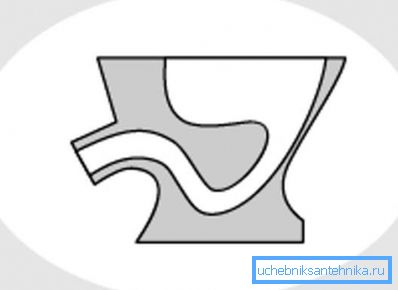
Designs with a bowl-type bowl differ in their characteristic configuration. For example, if the majority of toilet bowls are a funnel located in the center or with some displacement, then the dish-shaped bowl is equipped with a characteristic shelf - a plate.
Such devices were actively manufactured and used in the USSR, but today they are becoming more and more difficult to acquire. So, let's try to determine how the presence of the shelf affects the operation of the toilet bowl.
Operational features
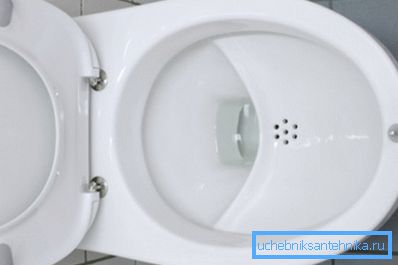
The owners of most funnel-shaped toilet bowls complain of characteristic splashes that minimize the comfort of the toilet. Plumbing disc type splashes to a lesser extent due to the fact that the liquid where sewage falls, is located closer to the upper line of the bowl than in devices with a bowl, made in the form of a funnel. This is the only significant advantage of designs with a shelf.
Among the shortcomings should be noted:
- High water consumption, because sewage does not slip due to its weight to the drain hole and they need to literally wash out no less than 5 liters of water.
- Stale smell in the toilet.
- The need for regular cleaning of the bowl with a brush and abrasive cleaners.
- Increased probability of formation of rust stains and streaks on the shelf, as there is constantly retained water.
- Such plumbing produced a limited number of brands. Therefore, if you find a disc-type toilet bowl for sale, be prepared for the fact that its price will be slightly higher than normal models.
Construction features
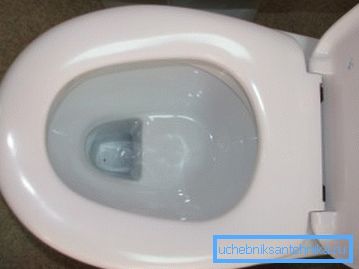
The most sought-after parameters for dishwashers are the following dimensions - 700x580x360 mm. Such dimensions are ideal for installation in the bathrooms of a city apartment or a country house.
Standard samples that can be found on the market are structurally a bowl with a characteristic recess (concave plate) located slightly above the drain hole.
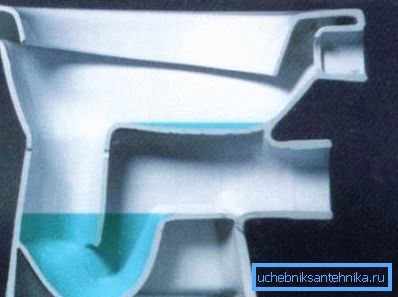
Toilets toilet type are divided into:
- direct release modifications;
- oblique release modifications.
Belonging to one category or another does not speak of any particular advantages, but is only explained by the peculiarities of the connection.
The design of new models of dish-shaped toilet bowls provides for the presence of 3 drain slots:
- bottom slot - used to flush the contents of the shelf;
- side cheeks - designed to wash the walls of the bowl.
Important: In order to prevent sticking of sewage to the shelf, on its surface there is always a thin layer of water.
In accordance with the placement of the cistern, toilets with a shelf are divided into the following types:
- modifications of the type “Compact”, where the tank is mounted on the bowl and looks like a whole;
- modifications of the suspended type, where the tank is not installed on the edge of the bowl, but mounted in a wall or on a wall.
Features of the installation work

Now that we have considered what a plumbing of a dish-shaped type is, it remains to understand how installation work is done with our own hands.
Installation instructions are simple, the main thing is to follow the recommendations below and not to save on the purchase of high-quality consumables.
- Initially, the base is prepared for installation.. The best option is a concrete or tile coating, which is characterized not only by durability and reliability, but also stability. In other words, the installed plumbing will not be swayed during operation.
Important: Modern toilet bowls, irrespective of modification and constructional features, are made to be laid and fixed directly on the tiled surface. But there is a way when a layer of rubber 5 mm thick is laid between the sole and the cover. As a rule, such an approach is justified in the event that the surface of the base in the bathroom is not even enough.
In addition, in Soviet times, the option of mounting on a taffeta, a wooden board embedded in concrete, was common. Now this method is irrelevant, since more simple and effective methods have appeared on the market.
- The toilet bowl is exposed on the prepared floor so that the outlet hole coincides with the sewer drain.
- Once the device is positioned properly, the foot is outlined with chalk or marker.. We insert a simple pencil into the holes intended for bolting, and make appropriate marks.
Important: We keep the pencil strictly perpendicular, otherwise after installation, the toilet will shift relative to the intended contour.
- Mark the holes and insert plastic seals in them.
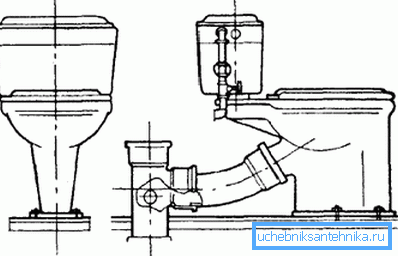
- Further, the outer grooves of the outlet and the inner surface of the runoff are lubricated with red lead based on drying oil.. Then a strand of tow is wound over the minium and the whole structure is pushed into the drain hole. For tightness, the compound obtained is coated with a layer of a solution of cement and liquid glass.
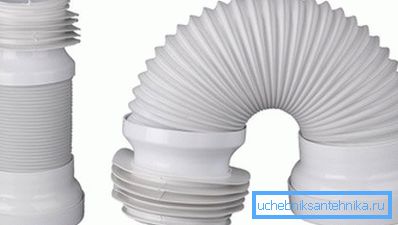
However, there is a simpler method, in which the outlet of the toilet bowl and the hole of the sewer drain is connected with the help of corrugations (accordions).
- After the toilet is attached to the drain, we tighten the fastening bolts and insert decorative plugs.
- The final step is to install the tank and connect the entire structure to the water supply.. Installation of a cistern on compact toilet bowls is carried out only through a hermetic rubber gasket.
Conclusion
Now you know what the advantages and disadvantages of dish-shaped toilet bowls are. In addition, now you have a general idea of the main stages of self-installation.
More useful information you can find by watching the video in this article.